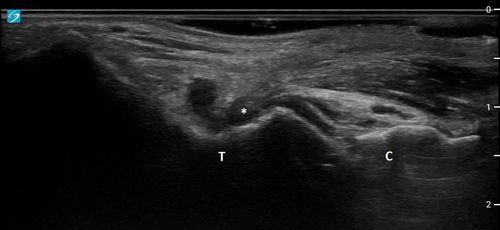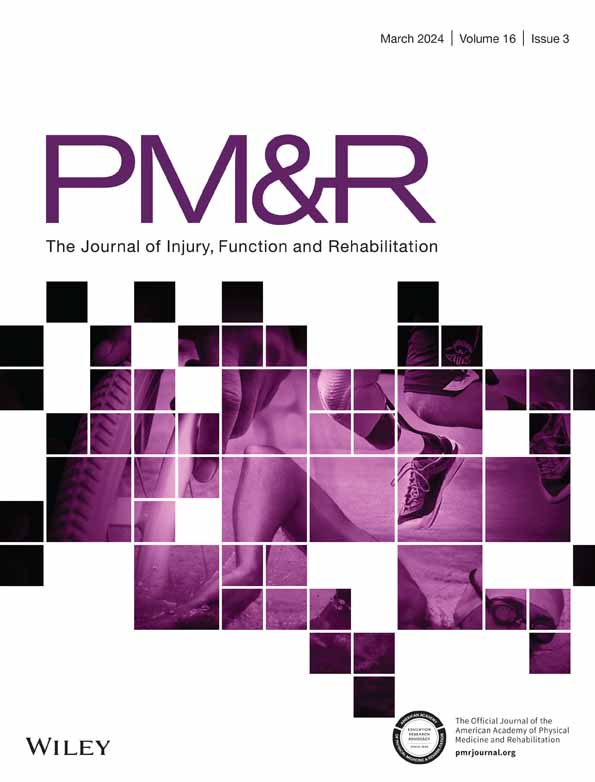Sinus tarsi ganglion in a figure skater: An unusual cause of ankle pain
A 16-year-old national-level figure skater was referred with a 4-week history of insidious atraumatic right-sided anterolateral ankle pain, worse with prolonged skating and landing on the affected foot during skating. The symptoms began after an intensive training camp. The pain persisted despite rest, physiotherapy, icing, and a course of nonsteroidal anti-inflammatory drugs.
Physical examination demonstrated bilateral pes planus, worse on the affected side. In addition, there was tenderness over the sinus tarsi, which was aggravated on terminal passive eversion and dorsiflexion.
A point-of-care ultrasound of the anterolateral aspect of the ankle was performed. This revealed a well-circumscribed, multilobulated, anechoic cystic structure arising from the subtalar joint, extending over the medial margin of the sinus tarsi, with pain reproduced on sono-palpation (Figure 1). Accordingly, she was diagnosed with sinus tarsi syndrome secondary to a sinus tarsi ganglion. Because of the nonresolving nature of the patient's symptoms, ultrasound-guided steroid injection was offered to facilitate active rehabilitation and quicker return to competitive training.

The patient was positioned in the left lateral decubitus position with the lateral side of the right ankle facing upwards, with the ankle in subtalar inversion.1 A high-frequency linear transducer was used to identify the lateral aspect of the posterior subtalar joint as demonstrated in Figure 2A.2 The transducer was moved lateral to medial to identify the cyst over the medial aspect of the sinus tarsi. Under real-time sonographic guidance, an 21-gauge, 2-inch needle was advanced in plane into the cyst, a common technique described for posterior subtalar joint injections in the literature.1-3 (Figure 2B) The cyst was partially aspirated with difficulty, due to its multiloculated and complex nature. Methylprednisolone (40 mg) diluted in 3 mL of 1% lidocaine was then injected into the cyst. The patient tolerated the procedure well without complications. She reported reduced pain immediately following the procedure, suggestive of a positive anesthetic effect. We also advised the patient to use appropriate shoe orthotics and perform ankle strengthening exercises post injection. At 2 months after injection, the patient reported that her symptoms had resolved, and she had returned to competitive figure skating.

Figure skaters are prone to injuries in the lower extremity, especially in the ankle, with off-ice training thought to be a contributory factor.4 Although most ankle injuries in this population result from ankle sprains, overuse injuries can also result from long training hours and the increasing demand in technical difficulty of the sport.4, 5
The sinus tarsi is an opening in the anterolateral ankle between the talar neck and the anterosuperior calcaneus. It is composed of various ligaments and retinacula, fat, vessels, and proprioceptive nerves and serves as an important stabilizer of the hindfoot.6 A ganglion cyst can form in the sinus tarsi region from the subtalar joint, where it is believed to develop from degeneration of surrounding ligaments or similar collagenous structures, usually after chronic instability or trauma of the subtalar joint.7
Sinus tarsi syndrome is a highly heterogenous clinical entity that presents with lateral hindfoot pain, worse on palpation and weight-bearing.8 It is often the result of acute ankle inversion injury, resulting in traumatic ligament damage.8 However, an insidious and atraumatic onset of pain in the sinus tarsi region may point toward atypical etiologies, such as a ganglion cyst in this patient. We suspected the formation of the ganglion cyst was induced by a sudden increase in training volume and presence of pes planus, which caused increased compressive and shear forces through the sinus tarsi.
Most causes of post-traumatic sinus tarsi syndrome resolve with conservative measures such as rest, physiotherapy, orthotics, and anti-inflammatory pharmacotherapy.8 However, further evaluation of the underlying etiology is required when conservative management is unsuccessful or when the etiology is atraumatic in nature. Point-of-care ultrasound can prove useful in correlating sono-anatomy with tender landmarks on physical examination.9 Additionally, although magnetic resonance imaging is the imaging modality of choice for sinus tarsi syndrome,7 point-of-care ultrasound can also aid in providing diagnostic clarity for the clinician to identify space-occupying pathologies that may not be amenable to conservative management, as demonstrated in this patient.
Current evidence suggests that arthroscopic debridement may be appropriate in patients with nonresolving sinus tarsi syndrome.8 Here we report the successful use of ultrasound-guided corticosteroid injection as an alternative to surgery for the management of sinus tarsi syndrome resulting from a sinus tarsi ganglion. Ultrasound-guided sinus tarsi injections have also been shown to have superior accuracy compared to palpation guided technique,3 and we believe this contributed to an excellent outcome in this case.
DISCLOSURES
None.
CONSENT
The patient gave their full consent to have their case analyzed, written up, and submitted to this journal.




